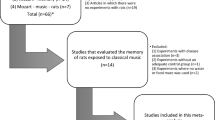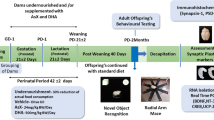Abstract
Early exposure to sevoflurane, an inhalation anesthetic, induces neurodegeneration in the developing brain and subsequent long-term neurobehavioral abnormalities. Here, we investigated whether an enriched environment could mitigate neonatal sevoflurane exposure-induced long-term cognitive and synaptic plasticity impairments. Male C57BL/6 mice were exposed to 3 % sevoflurane 2 h daily for 3 days from postnatal day 6 (P6) to P8. The exposed mice were randomly allocated to an enriched environment for 2 h daily between P8 and P42 or to a standard environment. Their behavior and cognition were assessed using open field (P35) and fear conditioning tests (P41–P42). Hematoxylin–eosin staining was used to study morphological changes in pyramidal neurons of hippocampal CA1 and CA3 regions. Synaptic plasticity alternations were assessed using western blotting, Golgi staining, and electrophysiological recording. We found that sevoflurane-exposed mice housed in a standard environment exhibited a reduced freezing response in the contextual test, decreased number of dendritic spines on pyramidal neurons and synaptic plasticity-related proteins in the hippocampus, and impaired long-term potentiation. However, in an enriched environment, some of these abnormities induced by repeated sevoflurane exposure. In conclusion, neonatal sevoflurane exposure-induced cognitive and synaptic plasticity impairments are ameliorated by an enriched environment.






Similar content being viewed by others
References
Callaway JK, Jones NC, Royse AG, Royse CF (2012) Sevoflurane anesthesia does not impair acquisition learning or memory in the Morris water maze in young adult and aged rats. Anesthesiology 117:1091–1101
Edwards DA, Shah HP, Cao W, Gravenstein N, Seubert CN, Martynyuk AE (2010) Bumetanide alleviates epileptogenic and neurotoxic effects of sevoflurane in neonatal rat brain. Anesthesiology 112:567–575
Gao J, Peng S, Xiang S, Huang J, Chen P (2014) Repeated exposure to propofol impairs spatial learning, inhibits LTP and reduces CaMKIIα in young rats. Neurosci Lett 560:62–66
Ishizeki J, Nishikawa K, Kubo K, Saito S, Goto F (2008) Amnestic concentrations of sevoflurane inhibit synaptic plasticity of hippocampal CA1 neurons through gamma-aminobutyric acid-mediated mechanisms. Anesthesiology 108:447–456
Ji MH et al (2015) Pre-administration of curcumin prevents neonatal sevoflurane exposure-induced neurobehavioral abnormalities in mice. Neurotoxicology 46:155–164
Kato R et al (2013) Neonatal exposure to sevoflurane causes significant suppression of hippocampal long-term potentiation in postgrowth rats. Anesth Analg 117:1429–1435
Kratzer S, Mattusch C, Kochs E, Eder M, Haseneder R, Rammes G (2012) Xenon attenuates hippocampal long-term potentiation by diminishing synaptic and extrasynaptic N-methyl-D-aspartate receptor currents. Anesthesiology 116:673–682
Leal G, Comprido D, Duarte CB (2014) BDNF-induced local protein synthesis and synaptic plasticity. Neuropharmacology 76 Pt C:639–656
Li S et al (2013) Environmental novelty activates β2-adrenergic signaling to prevent the impairment of hippocampal LTP by Aβ oligomers. Neuron 77:929–941
Liang G, Ward C, Peng J, Zhao Y, Huang B, Wei H (2010) Isoflurane causes greater neurodegeneration than an equivalent exposure of sevoflurane in the developing brain of neonatal mice. Anesthesiology 112:1325–1334
Lynch MA (2004) Long-term potentiation and memory. Physiol Rev 84:87–136
Nithianantharajah J, Hannan AJ (2006) Enriched environments, experience-dependent plasticity and disorders of the nervous system. Nat Rev Neurosci 7:697–709
Novkovic T, Mittmann T, Manahan-Vaughan D (2015) BDNF contributes to the facilitation of hippocampal synaptic plasticity and learning enabled by environmental enrichment. Hippocampus 25:1–15
Rappaport BA, Suresh S, Hertz S, Evers AS, Orser BA (2015) Anesthetic neurotoxicity—clinical implications of animal models. N Engl J Med 372:796–797
Rood BD, Calizo LH, Piel D, Spangler ZP, Campbell K, Beck SG (2014) Dorsal raphe serotonin neurons in mice: immature hyperexcitability transitions to adult state during first three postnatal weeks suggesting sensitive period for environmental perturbation. J Neurosci 34:4809–4821
Satomoto M et al (2009) Neonatal exposure to sevoflurane induces abnormal social behaviors and deficits in fear conditioning in mice. Anesthesiology 10:628–637
Servick K (2014) Biomedical research. Researchers struggle to gauge risks of childhood anesthesia. Science 346:1161–1162
Shen X et al (2013) Selective anesthesia-induced neuroinflammation in developing mouse brain and cognitive impairment. Anesthesiology 118:502–515
Shih J et al (2012) Delayed environmental enrichment reverses sevoflurane-induced memory impairment in rats. Anesthesiology 116:586–602
Simon W, Hapfelmeier G, Kochs E, Zieglgänsberger W, Rammes G (2001) Isoflurane blocks synaptic plasticity in the mouse hippocampus. Anesthesiology 94:1058–1065
Sprung J et al (2012) Attention-deficit/hyperactivity disorder after early exposure to procedures requiring general anesthesia. Mayo Clin Proc 87:120–129
Stratmann G et al (2009) Isoflurane differentially affects neurogenesis and long-term neurocognitive function in 60-day-old and 7-day-old rats. Anesthesiology 110:834–848
Tachibana K, Hashimoto T, Kato R, Tsuruga K, Ito R, Morimoto Y (2011) Long-lasting effects of neonatal pentobarbital administration on spatial learning and hippocampal synaptic plasticity. Brain Res 1388:69–76
Wang RR et al (2014) Neonatal ketamine exposure causes impairment of long-term synaptic plasticity in the anterior cingulate cortex of rats. Neuroscience 268:309–317
Wilder RT et al (2009) Early exposure to anesthesia and learning disabilities in a population-based birth cohort. Anesthesiology 110:796–804
Williams MR, DeSpenza T Jr, Li M, Gulledge AT, Luikart BW (2015) Hyperactivity of newborn Pten knock-out neurons results from increased excitatory synaptic drive. J Neurosci 35:943–959
Yang J et al (2015) Maged1 co-interacting with CREB through a hexapeptide repeat domain regulates learning and memory in mice. Mol Neurobiol 51:8–18
Conflict of interest
The authors declare that they have no conflict of interest.
Funding
This study was supported by the grants from the National Science Foundation of China (Nos. 81271216, 81300946, and 81471105).
Author information
Authors and Affiliations
Corresponding author
Additional information
Mu-huo Ji and Xing-ming Wang contributed equally to this work.
Rights and permissions
About this article
Cite this article
Ji, Mh., Wang, Xm., Sun, Xr. et al. Environmental Enrichment Ameliorates Neonatal Sevoflurane Exposure-Induced Cognitive and Synaptic Plasticity Impairments. J Mol Neurosci 57, 358–365 (2015). https://doi.org/10.1007/s12031-015-0627-1
Received:
Accepted:
Published:
Issue Date:
DOI: https://doi.org/10.1007/s12031-015-0627-1




